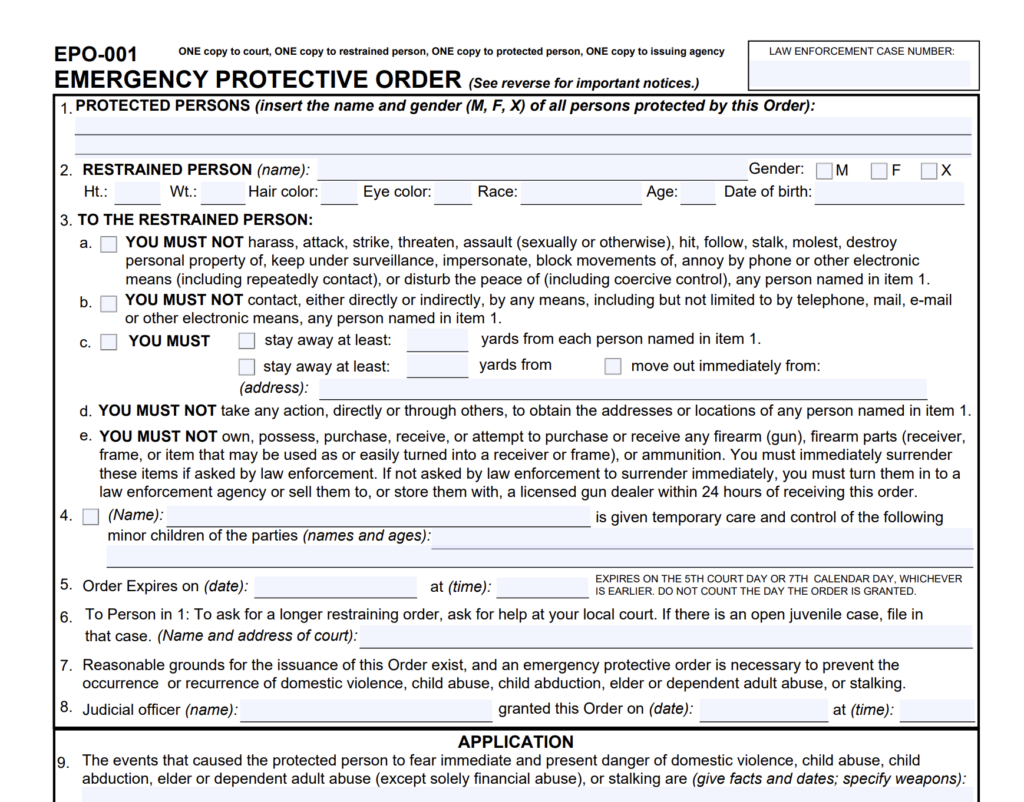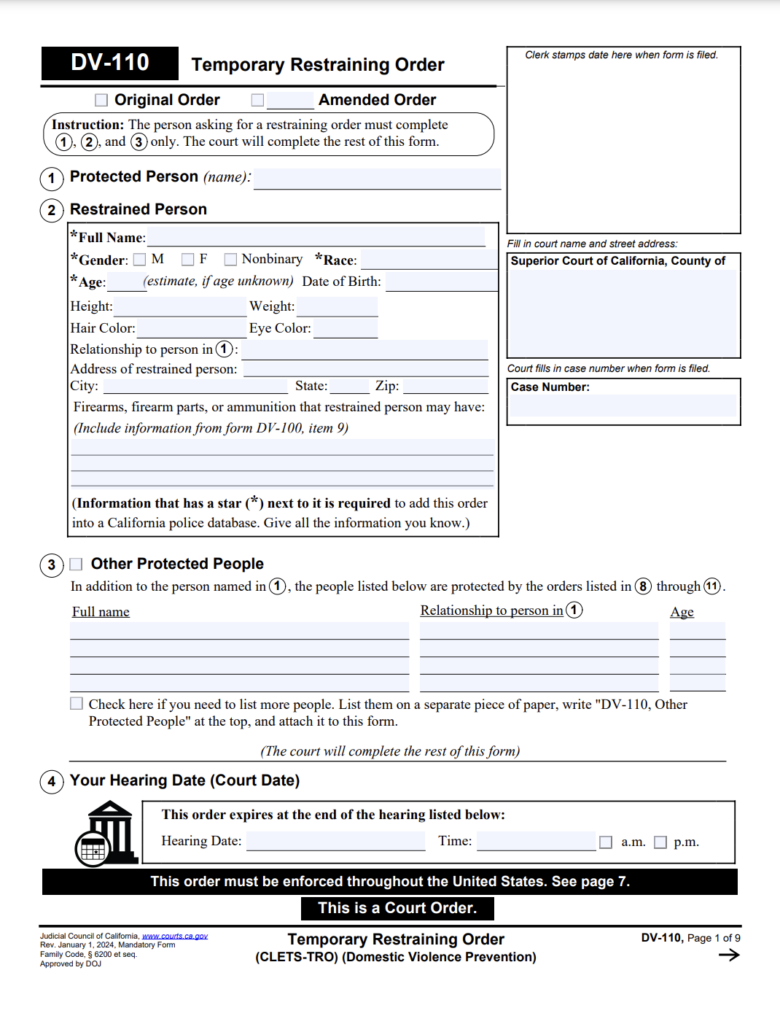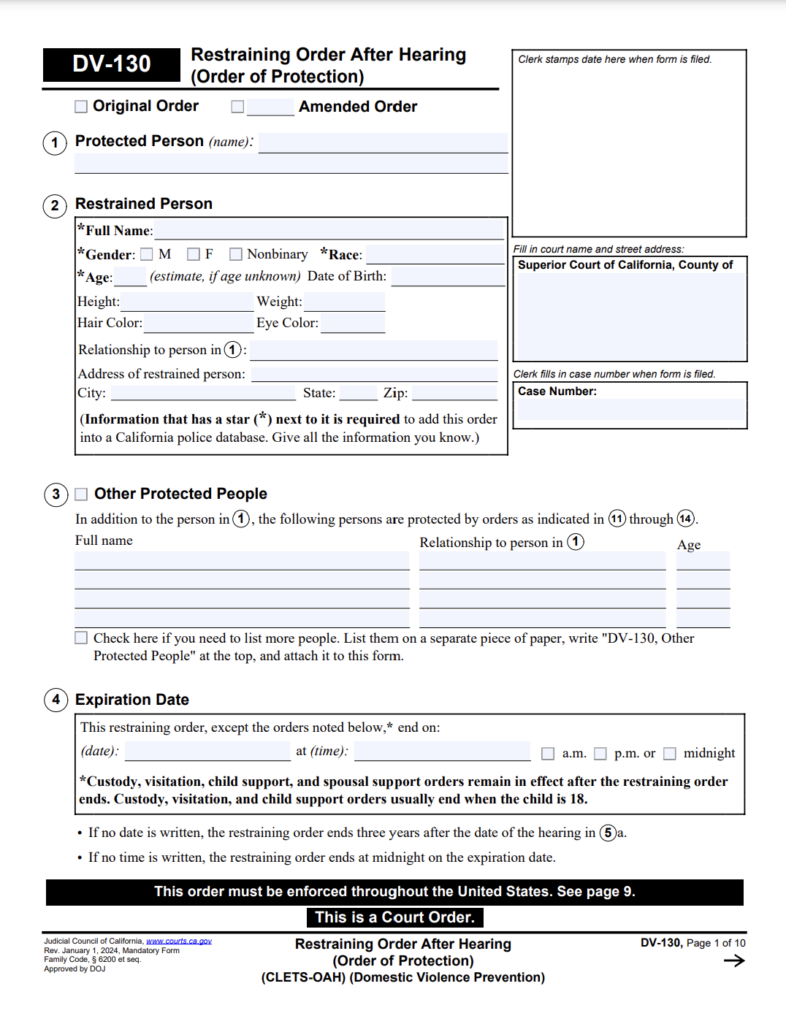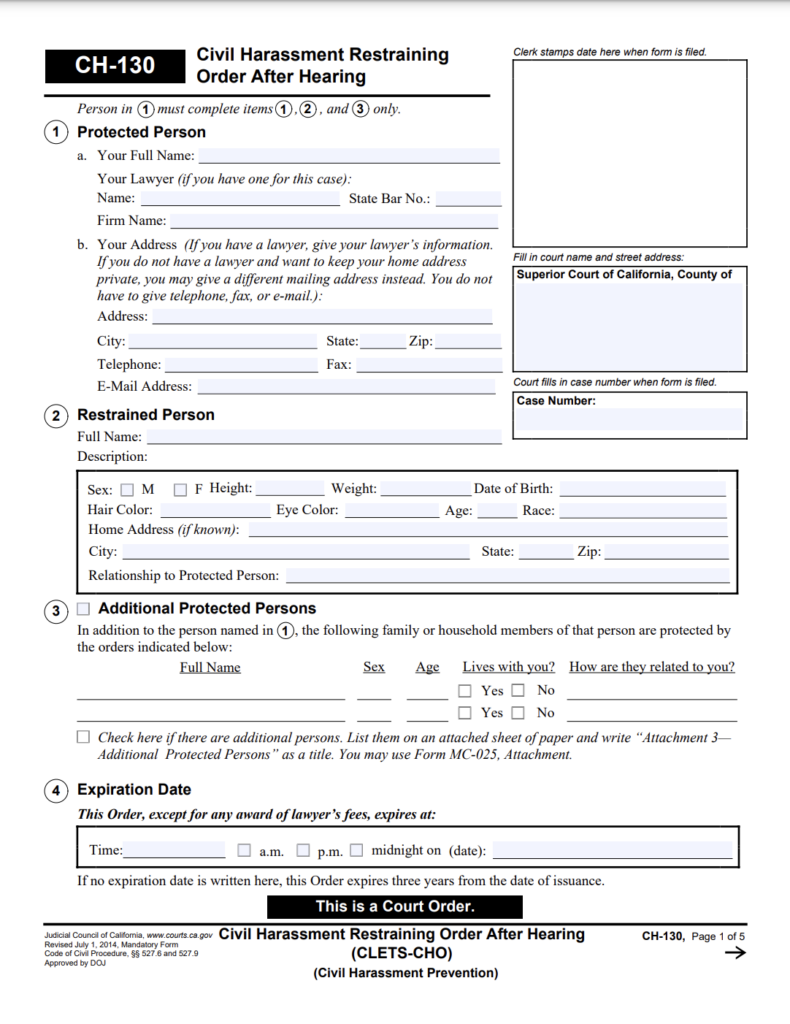When does a restraining order actually take effect after it’s been issued
Recently updated on December 22nd, 2025 at 11:34 am
Answer: A restraining order can take effect as soon as the abuser is given a copy i.e. served.
Here are the restraining orders which might be issued at different stages of a case. Only a full order is
Emergency Protective Order – Issued in some situations

A law enforcement officer can request an Emergency Protective Order (EPO) when responding to a crime, typically after the victim calls the police or 911 for help. The officer completes the Emergency Protective Order (form EPO-001) application and contacts a judge to review it. Judges are available 24/7 to approve these emergency orders.
The judge can issue an EPO to prevent further harm in cases involving domestic violence, child abuse, child abduction, stalking, or abuse of an elderly person or dependent adult.
An EPO can include orders that require the defendant to:
- Refrain from contacting the people protected by the order
- Avoid harassing, stalking, threatening, or harming those protected by the order
- Maintain a specified distance from protected individuals or places they frequently visit
- Move out of a residence shared with the protected person
- Surrender any guns, firearms, or ammunition
An EPO is temporary, usually lasting 5-7 days. If the person protected by the EPO needs longer protection or wishes to request additional orders, they can apply for a restraining order.
Temporary Restraining Order (TRO) — Issued in some situations
 OR
OR 
A Temporary Restraining Order (TRO) is issued as a stop gap measure which are valid for 2-3 weeks, until a decision on the permanent restraining order is taken at a formal court hearing. The official form on which the Temporary Restraining Order is issued depends on the situation: DV-110 for Domestic Violence which is for relationships that are romantic, or family, while CH-110 for Civil Harassment which is for all other relationships. Legally they hold the same force and have the same effect as the permanent restraining order, except the validity is shorter.
Restraining Orders in California are court orders issued in situations such as abuse, stalking or harassment in range of ways from a current or former lover or relative, a neighbor, a co-worker or even a caregiver which require the abuser to stay a certain distance away from, and refrain from contacting the victim. Failure to comply with the restraining order can result in criminal charges and therefore these serve as effectively a final warning. In practice, these are relatively simple to get from your local court, highly effective for the victim, and additionally provide coverage against abusive and harassment acts which are emotionally painful but not technically a crime.
In the overall process for getting a restraining order, a Temporary Restraining Order (TRO) might be issued after your initial set of paperwork is filed, and the hearing is set. If the judge thinks there are insufficient grounds, a Temporary Restraining Order (TRO) will not be issued.
(Full) Restraining Order
 OR
OR 
In California, a full (or permanent) restraining order takes effect once the judge grants it at a court hearing and it has been served to the restrained person. If the restrained person is present at the hearing when the judge issues the order, it goes into effect immediately, and no additional service is required.
If the restrained person is not present at the hearing, the order will not be legally effective until it is served. Service can be done by someone over 18 who is not involved in the case, or by law enforcement.
The full restraining order can last up to five years, depending on what the judge decides during the hearing.
Does my situation even qualify for filing for a Restraining Order
Before you do all the work of preparing and attempting to file the case documents, here’s a summary of the different types of restraining orders and the situations they apply to. There are a few different types of restraining orders and typically only one of them may apply to your situation. The first step is to see if any of the different types of restraining order applies to your situation or is remotely related as that might help you decide whether to apply .
The types are:

Domestic Violence is for situations involving domestic violence which is when a victim has been abused by a romantic partner (spouse, domestic partner, girlfriend/boyfriend) or a family member. For a complete overview of what is domestic violence please review: What is the legal definition of Domestic Violence in California
 Civil harassment applies to situations involving repeated irritating behavior, stalking, abuse, or threatened by someone you are not as close to as is required under domestic violence cases, like a roommate, a neighbor, or more distant family members like cousins, aunts or uncles, or nieces or nephews.
Civil harassment applies to situations involving repeated irritating behavior, stalking, abuse, or threatened by someone you are not as close to as is required under domestic violence cases, like a roommate, a neighbor, or more distant family members like cousins, aunts or uncles, or nieces or nephews.
 Elder Abuse: A senior citizen (or an adult who cannot function independently) is being abused by a caretaker, neighbor or child .
Elder Abuse: A senior citizen (or an adult who cannot function independently) is being abused by a caretaker, neighbor or child .
 Gun Violence: Typically, a police officer or sheriff who thinks someone might hurt themselves or someone else with a gun. This can stop that person from buying or owning a gun. It can’t order them to stay away from someone.
Gun Violence: Typically, a police officer or sheriff who thinks someone might hurt themselves or someone else with a gun. This can stop that person from buying or owning a gun. It can’t order them to stay away from someone.
 Workplace Violence: An employer usually requests these to protect their employee(s) from a person who has stalked, harassed, been violent or threatened violence at the workplace.
Workplace Violence: An employer usually requests these to protect their employee(s) from a person who has stalked, harassed, been violent or threatened violence at the workplace.
 School Violence involves violence, or threat of, against one or more students of a private postsecondary (after high school) school. This type of restraining order may only be granted if the threat of violence is for an act that would likely take place on the school’s campus, and is requested by school official.
School Violence involves violence, or threat of, against one or more students of a private postsecondary (after high school) school. This type of restraining order may only be granted if the threat of violence is for an act that would likely take place on the school’s campus, and is requested by school official.
Related Posts
Can I Appeal A Small Claims Judgment Illinois
Recently updated on December 22nd, 2025 at 11:12 amOverview In Illinois, every party in a small claims case—plaintiff or defendant—has the right to appeal a judgment entered by a circuit-court judge. Although the small claims division is designed for speed and informality, its decisions are legally binding. If you believe the judge misapplied the law,…
Illinois Small Claims court Process Self Represented
Recently updated on December 22nd, 2025 at 10:46 amOverview The Illinois Small Claims Court is designed for speed, simplicity, and self-representation. It handles civil disputes involving $10,000 or less, excluding interest and court costs. The process is structured to be accessible to citizens without lawyers—what Illinois courts call “pro se” litigants. By providing standardized forms,…
Illinois mall Claims Court Forms Fees
Recently updated on December 22nd, 2025 at 10:42 amOverview The Illinois Small Claims Court provides an efficient and affordable way for individuals and small businesses to resolve monetary disputes of $10,000 or less. Designed for self-represented litigants (pro se), the system simplifies traditional civil procedures through standardized forms, limited motion practice, and straightforward evidence rules.…
What Qualifies For Small Claims Court Illinois
Recently updated on December 22nd, 2025 at 10:48 amOverview The Illinois Small Claims Court exists to resolve civil disputes involving money claims of $10,000 or less. It provides a simple, fast, and affordable way for people to pursue justice without needing an attorney. The rules are governed by Illinois Supreme Court Rules 281–289, which simplify…





